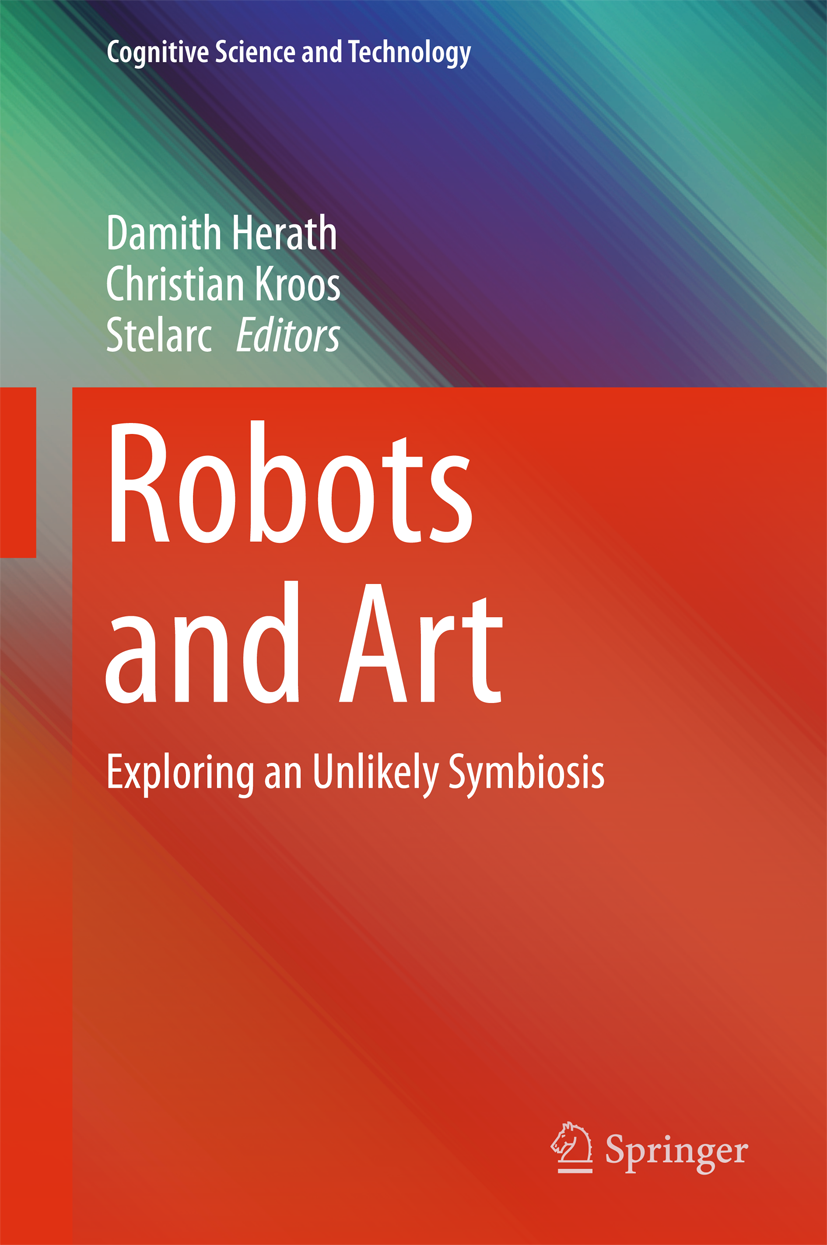eBook ISBN: 978-981-10-0321-9
DOI: 10.1007/978-981-10-0321-9
Number of Pages: XIX, 456
Number of Illustrations: 18 b/w, 200 colour
Robots and Art – The Book
The first compendium on robotic art of its kind, this book explores the integration of robots into human society and our attitudes, fears and hopes in a world shared with autonomous machines. It raises questions about the benefits, risks and ethics of the transformative changes to society that are the consequence of robots taking on new roles alongside humans. It takes the reader on a journey into the world of the strange, the beautiful, the uncanny and the daring – and into the minds and works of some of the world’s most prolific creators of robotic art.
 Damith Herath
Damith Herath
received his PhD in Robotics from the University of Technology, Sydney in 2008 while at the ARC Centre of Excellence for Autonomous Systems (CAS) and has a BSc (Hons) in Production Engineering, University of Peradeniya, Sri Lanka in 2001. He held a doctoral fellowship at CAS prior to joining MARCS Institute on the Thinking Head Project as the Research Engineer. At MARCS he led several robotic projects that explore various nuances of Human-Robot Interaction including reciprocal influences between the arts and robotics. His interests include autonomous robot navigation, localization and mapping, human-robot interaction and robotic art. Over the last four years he has contributed to a number of robotic art projects as the lead roboticist. He is also the convener and program co-chair of the 2011 International Conference on Robotics and Automation – Workshop on Robots and Art.
 Christian Kroos
Christian Kroos
received his M.A. and Ph.D. in Phonetics and Theatre Studies from the Ludwigs-Maximilians-Universität, München, Germany. His work on speech articulator movements and face motion during spoken language led to interdisciplinary research covering computer vision, cognitive sciences and robotics conducted internationally at the Institute of Phonetics and Speech Processing at Ludwigs-Maximilians-Universität (Germany), at ATR International (Japan) and at Haskins Laboratories (USA). At MARCS Institute, University of Western Sydney, Australia, he explored non-verbal human-machine interaction in the Thinking Head project. Besides his interest in robotic agents, he is still fascinated by human speech production and the evolution of language.
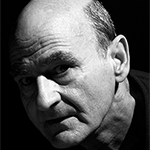 Stelarc
Stelarc
explores alternate anatomical architectures. He is an artist whose projects incorporate prosthetics, robotics, biotechnology, medical imaging and the internet. He has performed with a Third Hand, a Stomach Sculpture, Exoskeleton and a Prosthetic Head. Fractal Flesh, Ping Body and Parasite are internet performances that explore remote and involuntary choreography. He is surgically constructing and stem-cell growing an ear on his arm that will be internet enabled. In 1996 he was made an Honorary Professor of Art and Robotics at Carnegie Mellon University, Pittsburgh and in 2002 was awarded an Honorary Doctorate of Laws by Monash University, Melbourne. In 2010 was awarded the Ars Electronica Hybrid Arts Prize. In 2014 he initiated the Alternate Anatomies Lab. In 2015 he received the Australia Council’s Emerging and Experimental Arts Award. Stelarc is currently a Distinguished Research Fellow, School of Design and Art (SODA) at Curtin University. His artwork is represented by the Scott Livesey Galleries, Melbourne.
Prologue
1) Engineering the Arts (Herath & Kroos) | abstract
2) The Art in the Machine (Kroos)| abstract
Then and Now
3) We Have Always Been Robots: The History of Robots and Art (Stephens & Heffernan) | abstract In so doing, the chapter will make two key contributions to this book’s study of robots and art. Firstly, it will argue that the concept of a robot predates the emergence of the word robot by several centuries, and that our understanding of the contemporary concept is enriched by recognition of this longer history. Secondly, it will show that, from its very inception, the history of robots has been closely entwined with that of art—evident not least in the fact the term itself derives from the context of theatre. This history continues to be reflexively present in contemporary performance. 4) Robotics and Art, Computationalism and Embodiment (Penny) | abstract 5) Robotics: Hephaestus does it again (Laumond) | abstract
Epilogue
21) Encounters, Anecdotes and Insights in Prosthetics, Robotics and Art (Stelarc)| abstract
Otherness
6) Embracing Interdependencies: Machines, Humans and Non-humans (Amy Youngs) | abstract 7) Trans-species Interfaces: A manifesto for symbiogenisis (Ken Rinaldo) | abstract 8) Cultivating the Uncanny: The Telegarden and Other Oddities (Jochum & Goldberg) | abstract 8) The potential of otherness in robotic art (Sandry ) | abstract 10) Being one, being many (Kroos & Herath) | abstract
Explorations
11) Way of the Jitterbug (White) | abstract 12) Still and Useless: The Ultimate Automaton (Reeves & St-Onge ) | abstract 13) Machines that make art (Moura) | abstract
Embodiment
14) The Multiple Bodies of a Machine Performer (Demers) | abstract
I base the analysis on the passage of a walking robot, nicknamed Stumpy, from the AI lab to the stage, from functioning to performing. It shows how inherited competences from the historical body of the Tiller Girls contribute to its interpretive skills.
Finally, by examining the psychological perception of its movements, I am exploring audience mechanisms of empathy and identification towards those non-human performers.
15) Bio-Engineered Brains and Robotic Bodies: From Embodiment to Self-Portraiture (Ben-Ary & Ben-Ary) | abstract
16) Android robots as in-between beings (Ogawa & Ishiguro) | abstract
17) Into the Soft Machine (MacMurtie) | abstract
Interactions
18) I want to believe – empathy and catharsis in robotic art (Vorn) | abstract 19) Designing Robots Creatively (Velonaki & Rye) | abstract 20) Robot Partner – Are Friends Electric? (Doepner & Jurman) | abstract
Guy Ben-Ary and Gemma Ben-Ary, Louis-Philippe Demers, Stefan Doepner and Urška Jurman, Damith Herath, Elizabeth Jochum and Ken Goldberg, Christian Kroos, Jean-Paul Laumond, Chico MacMurtrie, Leonel Moura, Kohei Ogawa and Hiroshi Ishiguro, Simon Penny, Nicolas Reeves and David St-Onge, Ken Rinaldo, Eleanor Sandry, Stelarc, Elizabeth Stephens & Tara Heffernan, Mari Velonaki & David Rye, Bill Vorn, Norman T. White, Amy M. Youngs
An Encounter with the Strange, the Beautiful and the Uncanny + a Book Launch Event
Join us for an illuminating public discussion that sits at the edge of science and art. We have assembled an excellent panel from both sides of the art+science divide to explore the issues raised by the book in this premiere launch event.
A timely look at the future of robotics and the cultural, ethical issues arising from the proliferation of autonomous machines.
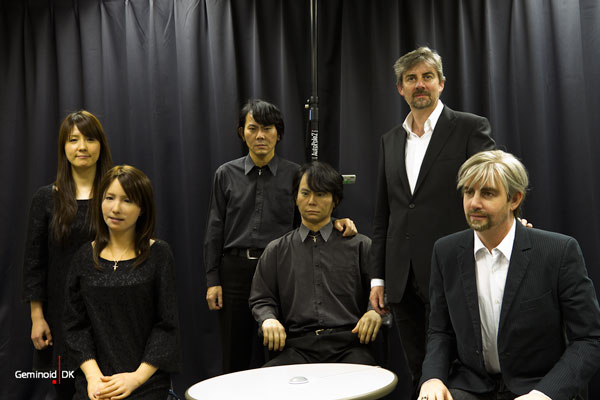
Discussion
The line-up of guests includes
 Stelarc – Described as a “legend and the most celebrated artist in the world working within technology and the visual arts” Stelarc is currently the Distinguished Professor and Research Fellow at the School of Design & Art, Curtin University.
Stelarc – Described as a “legend and the most celebrated artist in the world working within technology and the visual arts” Stelarc is currently the Distinguished Professor and Research Fellow at the School of Design & Art, Curtin University.
Prof. Mary-Anne Williams – Research Professor and Director, Innovation and Enterprise Research Laboratory (The Magic Lab), University of Technology Sydney.
Prof. David Rye – Australian Centre for Field Robotics, University of Sydney and the Creative Robotics Lab, National Institute of Experimental Arts, the University of New South Wales.
 Matthew Connell – Principal Curator Museum of Applied Arts & Sciences. (The Powerhouse Museum)
Matthew Connell – Principal Curator Museum of Applied Arts & Sciences. (The Powerhouse Museum)
 Shara Evans – Futurist, keynote speaker, commentator, strategy advisor and thought leader.
Shara Evans – Futurist, keynote speaker, commentator, strategy advisor and thought leader.
The panel will be moderated by
 Prof. Edward Scheer – Author of “The Infinity Machine” and other books. School of the Arts & Media, University of New South Wales.
Prof. Edward Scheer – Author of “The Infinity Machine” and other books. School of the Arts & Media, University of New South Wales.
with an introduction by Dr. Hank Haeusler.
Program Chair: Dr. Damith Herath
DATE & TIME
Thursday, 16 June 2016 6.00pm for a 6.30pm start
VENUE
Michael Crouch Innovation Centre, UNSW
Ground Floor, Material Science Building, E10
Enter via Gate 2, High St
Kensington, NSW
RSVP
Bookings essential.




An Encounter with the Machine Kind + a Book Launch Event
Stelarc in conversation
A timely look at the future of robotics and the cultural, ethical issues arising from the proliferation of autonomous machines. Renowned performance artist Stelarc will be in conversation with Prof. Graham Durant AM and Dr. Stuart Kohlhagen PSM. Enjoy an hour of stimulating discussion on robotic art in this second edition of the book launch series based on the book “Robots and Art: Exploring an Unlikely Symbiosis”.
Program Chair: Dr. Damith Herath
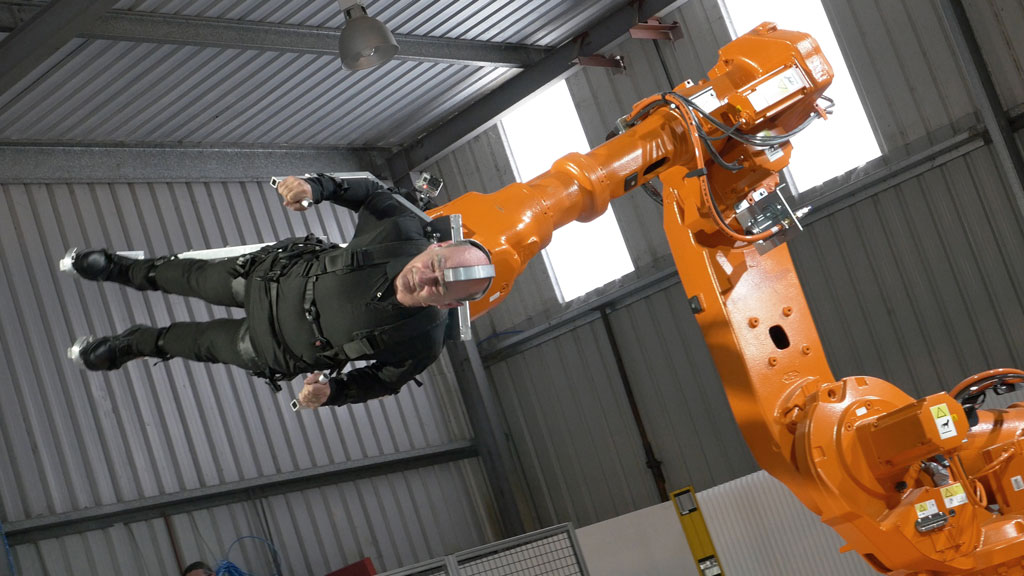
 Stelarc – Described as a “legend and the most celebrated artist in the world working within technology and the visual arts” Stelarc is currently the Professor and Distinguished Research Fellow at the School of Design & Art, Curtin University.
Stelarc – Described as a “legend and the most celebrated artist in the world working within technology and the visual arts” Stelarc is currently the Professor and Distinguished Research Fellow at the School of Design & Art, Curtin University.
 Professor Graham Durant AM – Graham was appointed Director of Questacon in 2003. He is a highly experienced museum and science centre leader with a distinguished academic background and international reputation. Graham helped develop the Inspiring Australia strategy and is an Honorary Professor at the Australian National University. He was awarded an AM in 2012.
Professor Graham Durant AM – Graham was appointed Director of Questacon in 2003. He is a highly experienced museum and science centre leader with a distinguished academic background and international reputation. Graham helped develop the Inspiring Australia strategy and is an Honorary Professor at the Australian National University. He was awarded an AM in 2012.
 Dr Stuart Kohlhagen PSM – Stuart has worked with Questacon for the past 33 years, during which time he has lead the design and development of interactive exhibits on a wide range of topics. In 2000 he was awarded the Public Service Medal for his contribution to informal science education and in 2013 won the ‘Iron Science Teacher’ competition at the renowned Exploratorium Teachers Institute. He is currently President of the Australian Science and Technology Exhibitors Network (ASTEN).
Dr Stuart Kohlhagen PSM – Stuart has worked with Questacon for the past 33 years, during which time he has lead the design and development of interactive exhibits on a wide range of topics. In 2000 he was awarded the Public Service Medal for his contribution to informal science education and in 2013 won the ‘Iron Science Teacher’ competition at the renowned Exploratorium Teachers Institute. He is currently President of the Australian Science and Technology Exhibitors Network (ASTEN).
DATE & TIME
Friday, 17 June 2016 6.00pm for a 6.30pm start
VENUE
Questacon – the National Science and Technology Centre
King Edward Terrace
Parkes ACT 2600
RSVP
Bookings essential.



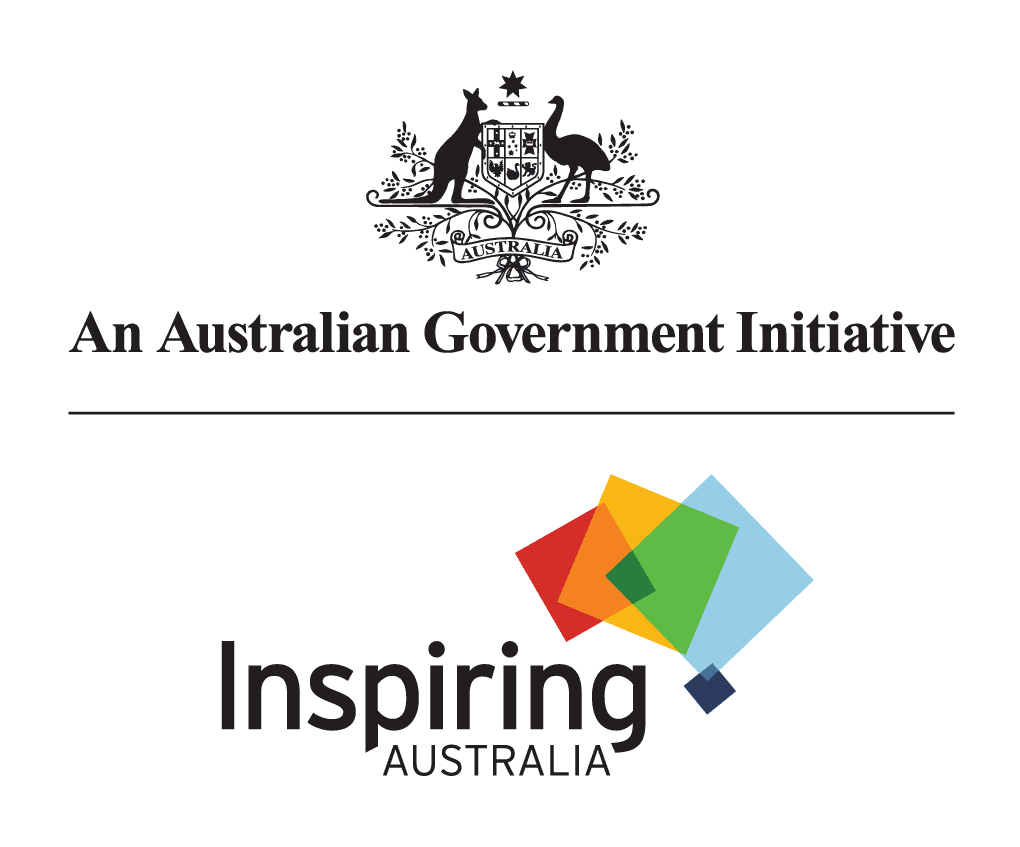
High tech, low art?*
Discussion
Artists, working together with engineers and scientists, have often raised questions about future directions of technology and confronted the public with practical, social and ethical consequences before new technologies reached general adoption. Robots and robotic art are a special case of this. But the relationships between the disciplines have not always been amicable. Artists, scientists, engineers and designers working across ‘the divide’ often find themselves having to defend their cross discipline ventures.
Program Chair: Dr Christian Kroos
Is there indeed a rift? Is technology that is designed to interact with humans in everyday life particularly vulnerable to one sided views? Can art, design, science and engineering be friends?.
Panel:
David Frohlich, School of Arts, University of Surrey
Damith Herath, University of Canberra, Australia
Christian Kroos, CVSSP, University of Surrey
Kirk Woolford, School of Arts, University of Surrey
* Performance artist Stelarc reported being confronted with this dictum in his early career.
DATE & TIME
Wednesday, 6th July 2016, 11:00 am
VENUE
Surrey Space Centre, 13/15 BA 01
University of Surrey
Guildford, GU2 7XH
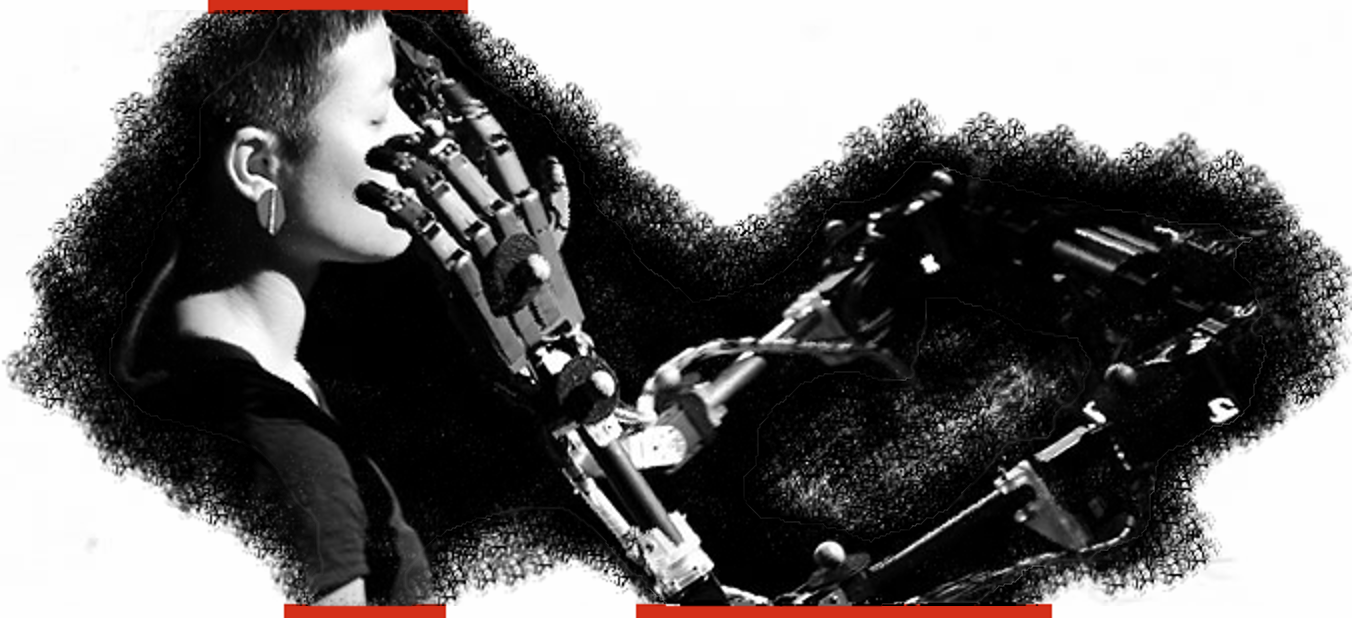


ROBOTS AND ART: EXPLORING AN UNLIKELY SYMBIOSIS
A Perth Science Festival Event
Stelarc is one of the world’s most prolific creators of robotic art and you have the chance to meet him in person as we launch his new book: Robots and Art (co-edited by Damith Herath, Christian Kroos and Stelarc). Journey into a world of the strange, the beautiful and the daring with Stelarc and an expert panel of speakers as they discuss the significance of robots integrating into human society with PICA Acting Curator Andrew Varano.
Panel:
Stelarc, Artist

DATE & TIME
Saturday 13 August, 2016 4pm – 5pm
VENUE
Perth Institute of Contemporary Art
PICA Reading Room
51 James Street Northbridge Perth, WA, 6003

